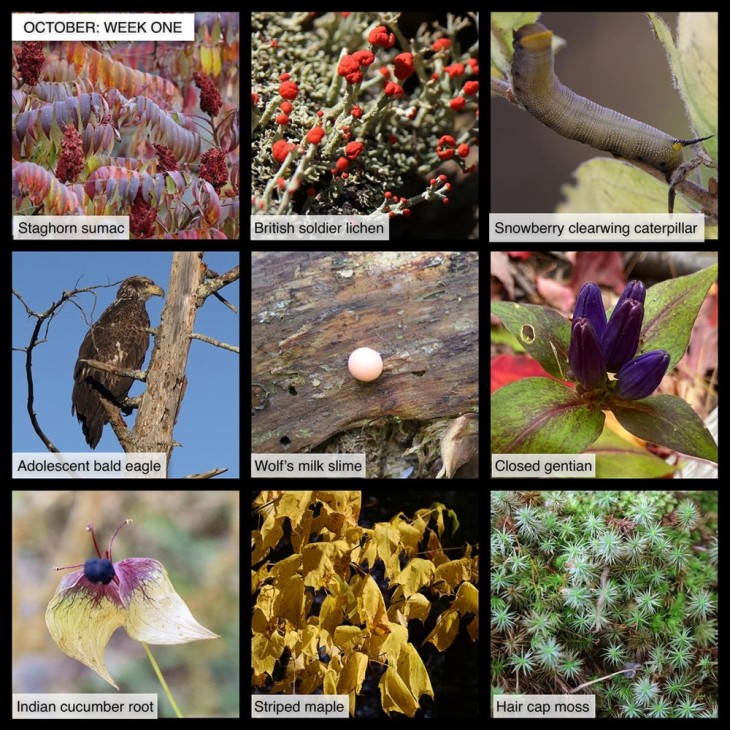This Week in the Woods, we’ve been enjoying the much-needed rain, as well as occasional glimpses of migratory birds.
In a typical year, staghorn sumac, a common shrub of field edges and roadsides, has brilliantly colored fall foliage, and many specimens are bright scarlet. In this drought year, some staghorn sumacs still have that intense scarlet, but many are showing more muted (but still beautiful) colors. Although this shrub is often discounted as an overgrown weed, there’s a lot to recommend it. It grows quickly in attractive stands that can be shaped to form shaded walks or hidden outdoor rooms. Its nectar feeds a variety of bees and other pollinators, and its distinctive red drupes are an important food for birds in late winter, when other, more favored foods are depleted. Here’s a profile from the Macphail Woods Ecological Forestry Project.
We don’t know when British soldier lichen got its common name, but the reference is to the color of its fruiting bodies, and the British “Redcoat” uniforms worn during the American Revolution. This common lichen grows on both wood and the soil. A fun fact from Lichens of North America (Brood, Sharnoff & Sharnoff): British soldier lichen tends to be more squamulose (scaly) when it grows in the shade. Here’s an Outside Story article by Meghan McCarthy McPhaul.
Snowberry clearwings, also known as hummingbird moths, have two broods of caterpillars each summer. The second brood is active now, and we found one happily munching away on invasive honeysuckle. As is so often the case, naturalist Mary Holland previously found what we just discovered. Check out this posting from her Naturally Curious blog, describing how the caterpillars fall to the ground in late autumn and spin cocoons.
Who is that big, scraggly brown bird with white patches? It’s a young bald eagle, and as noted in this Outside Story essay, it still has a lot of growing up to do: “As the fledgling wing feathers molt, beginning when the eagle is around nine months old, they grow back at the slightly shorter, adult length. The result is a jagged appearance that persists for about two years, until all of the original set of primary and secondary feathers have been replaced.” The brown coloration may serve a signaling function, indicating to mature adults that the youngsters aren’t a threat to breeding territories. That’s important, because on top of looking messy, young eagles are still learning how to fend for themselves and often follow adults, learning from their behavior.
That cute pink button mushroom on a log isn’t actually a mushroom. It’s the fruiting body of wolf’s milk slime mold, a member of the uncanny class of organisms, Myxogastria (Myxomycetes). Slime molds exist at different times as roving ameboids, and then (after the ameboids suddenly merge together) a much bigger, albeit still unicellular plasmoids (slimes). These slimes can achieve impressive feats, for example, figuring out the most efficient paths to harvest sources of food. Here’s a write-up on Myxomycetes from Cornell University’s College of Agriculture and Life Sciences. And here’s a mind-blowing clip from the BBC, showing a slime mold more-or-less mapping the Tokyo subway system (and yes we shared it previously, but worth a second viewing!)
As its name indicates, closed gentian doesn’t open. For pollination, it relies mostly on the brute strength of bumblebees, which are strong enough to push their way in. You’ll often find this late-season flower in floodplains and other low-lying places. Here’s a profile from the U.S. Forest Service.
We’ve previously written about Indian cucumber root. You can occasionally find its berries now, although most of them get gobbled up before they ripen. These woodland plants have a flower-like autumn display, with whorls of yellow leaves that have rosy splashes in the center. Here’s a profile from The Native Plant Trust, including some good photos of the berries and autumn coloration.
In such a dry year, many striped maples look droopy, but they still supply intense yellow hues to the autumn woods. They’re also called moose maple (because moose often browse them), goosefoot (because of their goose foot-shaped leaves), snake maple (because of the markings on their bark) and in at least on family circle, leaf boat maple (because their large leaves are ideal for impromptu streamside shipbuilding). Here’s a profile of the species from Adirondacks Forever Wild, which notes the species’ importance both as a food source for wildlife, and as a contributor to the “vertical diversity” of the woods: as an abundantly growing small tree, it creates both food and shelter opportunities for species that inhabit the rich middle space between the ground and high canopy.
Hair cap moss (multiple species) is a starry-shaped moss that often grows in thick clumps. It’s evergreen and stands out against the fall leaf litter. Mosses are ancient, non-vascular plants which provide important but mostly-overlooked services on the forest floor, such as reducing soil erosion and creating shelter for small creatures near the bottom of the food web. Here’s a helpful general write-up about mosses from the U.S. Forest Service, and photos of common hair cap moss from iNaturalist.
In this difficult period, many of us find joy in observing local nature, and many families are seeking outdoor enrichment opportunities for children. Here are nine photographs taken this past week, most within 15 miles of the Northern Woodlands office in Lyme, New Hampshire. We hope you enjoy using this grid as a prompt for your own explorations, or as the basis for a game of family forest tic-tac-toe.
What are you seeing in the woods this week? Share your images with us on Facebook, or submit a special photo for possible inclusion in our monthly online Reader Photo Gallery.



Discussion *